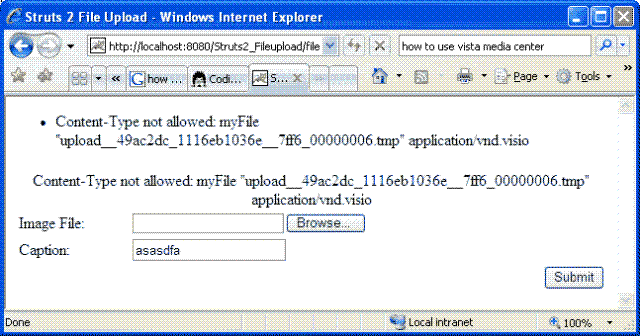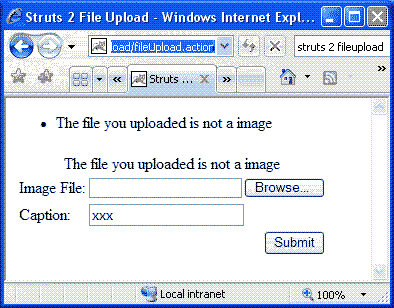struts2 文件上传
实现原理
Struts 2是通过Commons FileUpload文件上传。Commons FileUpload通过将HTTP的数据保存到临时文件夹,然后Struts使用fileUpload拦截器将文件绑定到Action的实例中。从而我们就能够以本地文件方式的操作浏览器上传的文件。
具体实现
以下是例子所依赖类包的列表:
首先,创建文件上传页面FileUpload.jsp,内容如下:
<%@ page language="java" contentType="text/html; charset=UTF-8"
pageEncoding="UTF-8"%>
<%@ taglib uri="/struts-tags" prefix="s"%>
<!DOCTYPE html PUBLIC "-//W3C//DTD HTML 4.01 Transitional//EN" "http://www.w3.org/TR/html4/loose.dtd">
<html>
<head>
<meta http-equiv="Content-Type" content="text/html; charset=UTF-8">
<title>Insert title here</title>
</head>
<body>
<s:form action="upload" method="post" enctype="multipart/form-data">
<s:file name="myFile" />
<s:submit />
</s:form>
</body>
</html>
在FileUpload.jsp中,先将表单的提交方式设为POST,然后将enctype设为multipart/form-data,这并没有什么特别之处。接下来,<s:file/>标志将文件上传控件绑定到Action的myFile属性。
其次是UploadAction.java代码:
package com.student.action;
import java.io.File;
import java.io.FileInputStream;
import java.io.FileOutputStream;
import java.util.Date;
import org.apache.struts2.ServletActionContext;
import com.opensymphony.xwork2.ActionSupport;
public class UpLoadAction extends ActionSupport {
private File myFile;
private String myFileContentType;
private String myFileFileName;
private String AllowedType;
public File getMyFile() {
return myFile;
}
public void setMyFile(File myFile) {
this.myFile = myFile;
}
public String getMyFileContentType() {
return myFileContentType;
}
public void setMyFileContentType(String myFileContentType) {
this.myFileContentType = myFileContentType;
}
public String getMyFileFileName() {
return myFileFileName;
}
public void setMyFileFileName(String myFileFileName) {
this.myFileFileName = myFileFileName;
}
public String getAllowedType() {
return AllowedType;
}
public void setAllowedType(String allowedType) {
AllowedType = allowedType;
}
public String execute() throws Exception {
String imageFileName = new Date().getTime() + getExtention(getMyFileFileName());
String path = ServletActionContext.getServletContext().getRealPath("/")+"/images";
ServletActionContext.getRequest().setAttribute("imageFileName", imageFileName);
FileInputStream fis = new FileInputStream(getMyFile());
FileOutputStream fos = new FileOutputStream(path+"/"+ imageFileName);
byte[] b = new byte[1024];
int len = 0;
while((len = fis.read(b))!=-1){
fos.write(b, 0, len);
}
fis.close();
fos.close();
return SUCCESS;
}
//获得文件的后缀
private static String getExtention(String fileName){
int pos = fileName.lastIndexOf( "." );
return fileName.substring(pos);
}
}
在FileUploadAction中我分别写了setMyFileContentType、setMyFileFileName、setMyFile和 setCaption四个Setter方法,后两者很容易明白,分别对应FileUpload.jsp中的<s:file/> 和<s:textfield/>标志。但是前两者并没有显式地与任何的页面标志绑定,那么它们的值又是从何而来的呢?其实,<s:file/>标志不仅仅是绑定到myFile,还有myFileContentType(上传文件的MIME类型)和 myFileFileName(上传文件的文件名,该文件名不包括文件的路径)。因此,<s:file name="xxx" />对应Action类里面的xxx、xxxContentType和xxxFileName三个属性。
FileUploadAction作用是将浏览器上传的文件拷贝到WEB应用程序的UploadImages文件夹下,新文件的名称是由系统时间与上传文件的后缀组成,该名称将被赋给imageFileName属性,以便上传成功的跳转页面使用。
下面我们就来看看上传成功的页面:
<%@ page language="java" contentType="text/html; charset=UTF-8"
pageEncoding="UTF-8"%>
<%@ taglib uri="/struts-tags" prefix="s"%>
<!DOCTYPE html PUBLIC "-//W3C//DTD HTML 4.01 Transitional//EN" "http://www.w3.org/TR/html4/loose.dtd">
<html>
<head>
<meta http-equiv="Content-Type" content="text/html; charset=UTF-8">
<title>Insert title here</title>
</head>
<body>
<div style="padding: 3px; border: solid 1px #cccccc; text-align: center">
<img src="images/${imageFileName}" />
<br />
</div>
</body>
</html>
然后是Action的配置文件:
<action name="upload" class="com.student.action.UpLoadAction1">
<interceptor-ref name="fileUpload">
<param name="allowedTypes">
image/bmp,image/png,image/gif,image/jpeg,image/pjpeg
</param>
<param name="maximumSize">1048576</param>
</interceptor-ref>
<interceptor-ref name="defaultStack" />
<result name="success">/success.jsp</result>
<result name="input">/upload.jsp</result>
</action>
最后是web.xml配置文件:
<?xml version="1.0" encoding="UTF-8"?>
<web-app version="2.4"
xmlns="http://java.sun.com/xml/ns/j2ee"
xmlns:xsi="http://www.w3.org/2001/XMLSchema-instance"
xsi:schemaLocation="http://java.sun.com/xml/ns/j2ee
http://java.sun.com/xml/ns/j2ee/web-app_2_4.xsd">
<filter>
<filter-name> struts-cleanup </filter-name>
<filter-class>
org.apache.struts2.dispatcher.ActionContextCleanUp
</filter-class>
</filter>
<filter>
<filter-name>struts2</filter-name>
<filter-class>org.apache.struts2.dispatcher.FilterDispatcher</filter-class>
</filter>
<filter-mapping>
<filter-name> struts-cleanup </filter-name>
<url-pattern> /* </url-pattern>
</filter-mapping>
<filter-mapping>
<filter-name>struts2</filter-name>
<url-pattern>/*</url-pattern>
</filter-mapping>
<welcome-file-list>
<welcome-file>index.jsp</welcome-file>
</welcome-file-list>
</web-app>
发布运行应用程序,在浏览器地址栏中键入:http://localhost:8080/Struts2_Fileupload/FileUpload.jsp,出现图示页面:
选择图片文件,填写Caption并按下Submit按钮提交,出现图示页面:
清单8 上传成功页面
更多配置
在运行上述例子,如果您留心一点的话,应该会发现服务器控制台有如下输出:
Mar 20 , 2007 4 : 08 : 43 PM org.apache.struts2.dispatcher.Dispatcher getSaveDir INFO: Unable to find 'struts.multipart.saveDir' property setting. Defaulting to javax.servlet.context.tempdir Mar 20 , 2007 4 : 08 : 43 PM org.apache.struts2.interceptor.FileUploadInterceptor intercept INFO: Removing file myFile C:\Program Files\Tomcat 5.5 \work\Catalina\localhost\Struts2_Fileupload\upload_251447c2_1116e355841__7ff7_00000006.tmp
清单9 服务器控制台输出
上述信息告诉我们,struts.multipart.saveDir没有配置。struts.multipart.saveDir用于指定存放临时文件的文件夹,该配置写在struts.properties文件中。例如,如果在struts.properties文件加入如下代码:
struts.multipart.saveDir = /tmp
清单10 struts配置
这样上传的文件就会临时保存到你根目录下的tmp文件夹中(一般为c:\tmp),如果此文件夹不存在,Struts 2会自动创建一个。
错误处理
上述例子实现的图片上传的功能,所以应该阻止用户上传非图片类型的文件。在Struts 2中如何实现这点呢?其实这也很简单,对上述例子作如下修改即可。
首先修改FileUpload.jsp,在<body>与<s:form>之间加入“<s:fielderror />”,用于在页面上输出错误信息。
然后修改struts.xml文件,将Action fileUpload的定义改为如下所示:
< action name ="fileUpload" class ="tutorial.FileUploadAction" >
< interceptor-ref name ="fileUpload" >
< param name ="allowedTypes" >
image/bmp,image/png,image/gif,image/jpeg
</ param >
</ interceptor-ref >
< interceptor-ref name ="defaultStack" />
< result name ="input" > /FileUpload.jsp </ result >
< result name ="success" > /ShowUpload.jsp </ result >
</ action >
清单11 修改后的配置文件
显而易见,起作用就是fileUpload拦截器的allowTypes参数。另外,配置还引入defaultStack它会帮我们添加验证等功能,所以在出错之后会跳转到名称为“input”的结果,也即是FileUpload.jsp。
发布运行应用程序,出错时,页面如下图所示:
清单12 出错提示页面
上面的出错提示是Struts 2默认的,大多数情况下,我们都需要自定义和国际化这些信息。通过在全局的国际资源文件中加入“struts.messages.error.content.type.not.allowed=The file you uploaded is not a image”,可以实现以上提及的需求。
实现之后的出错页面如下图所示:
同样的做法,你可以使用参数“maximumSize”来限制上传文件的大小,它对应的字符资源名为:“struts.messages.error.file.too.large”。
字符资源“struts.messages.error.uploading”用提示一般的上传出错信息。
其中UpLoadAction还可以写成如下形式:
package com.student.action;
import java.io.BufferedInputStream;
import java.io.BufferedOutputStream;
import java.io.File;
import java.io.FileInputStream;
import java.io.FileNotFoundException;
import java.io.FileOutputStream;
import java.io.IOException;
import java.io.InputStream;
import java.io.OutputStream;
import java.util.Date;
import org.apache.struts2.ServletActionContext;
import com.opensymphony.xwork2.ActionSupport;
public class UpLoadAction1 extends ActionSupport {
private static final int BUFFER_SIZE = 2 * 1024;
private File myFile;
private String myFileContentType;
private String myFileFileName;
public File getMyFile() {
return myFile;
}
public void setMyFile(File myFile) {
this.myFile = myFile;
}
public String getMyFileContentType() {
return myFileContentType;
}
public void setMyFileContentType(String myFileContentType) {
this.myFileContentType = myFileContentType;
}
public String getMyFileFileName() {
return myFileFileName;
}
public void setMyFileFileName(String myFileFileName) {
this.myFileFileName = myFileFileName;
}
public String execute() throws Exception {
File src = getMyFile();
String dstPath = ServletActionContext.getServletContext().getRealPath("/")+"/images";
String imageFileName = getImageFileName(getMyFileFileName());
ServletActionContext.getRequest().setAttribute("imageFileName", imageFileName);
File dst = new File(dstPath+"/"+imageFileName);
copy(src, dst);
return SUCCESS;
}
//将指定的文件拷贝到指定的目录
public static void copy(File src,File dst){
InputStream in = null;
OutputStream out = null;
try {
in = new BufferedInputStream(new FileInputStream(src),BUFFER_SIZE);
out = new BufferedOutputStream(new FileOutputStream(dst),BUFFER_SIZE);
byte[] b = new byte[1024];
int len = 0;
while((len = in.read(b))!= -1){
out.write(b, 0, len);
}
} catch (FileNotFoundException e) {
e.printStackTrace();
} catch (IOException e) {
e.printStackTrace();
}finally{
try {
if(null!=in){
in.close();
}
if(null!=out) {
out.close();
}
} catch (IOException e) {
e.printStackTrace();
}
}
}
//根据当前时间给文件取指定的名字
public static String getImageFileName(String fileName){
return new Date().getTime() + getExtention(fileName);
}
//获取文件的后缀
public static String getExtention(String fileName){
int pos = fileName.lastIndexOf(".");
return fileName.substring(pos);
}
}




